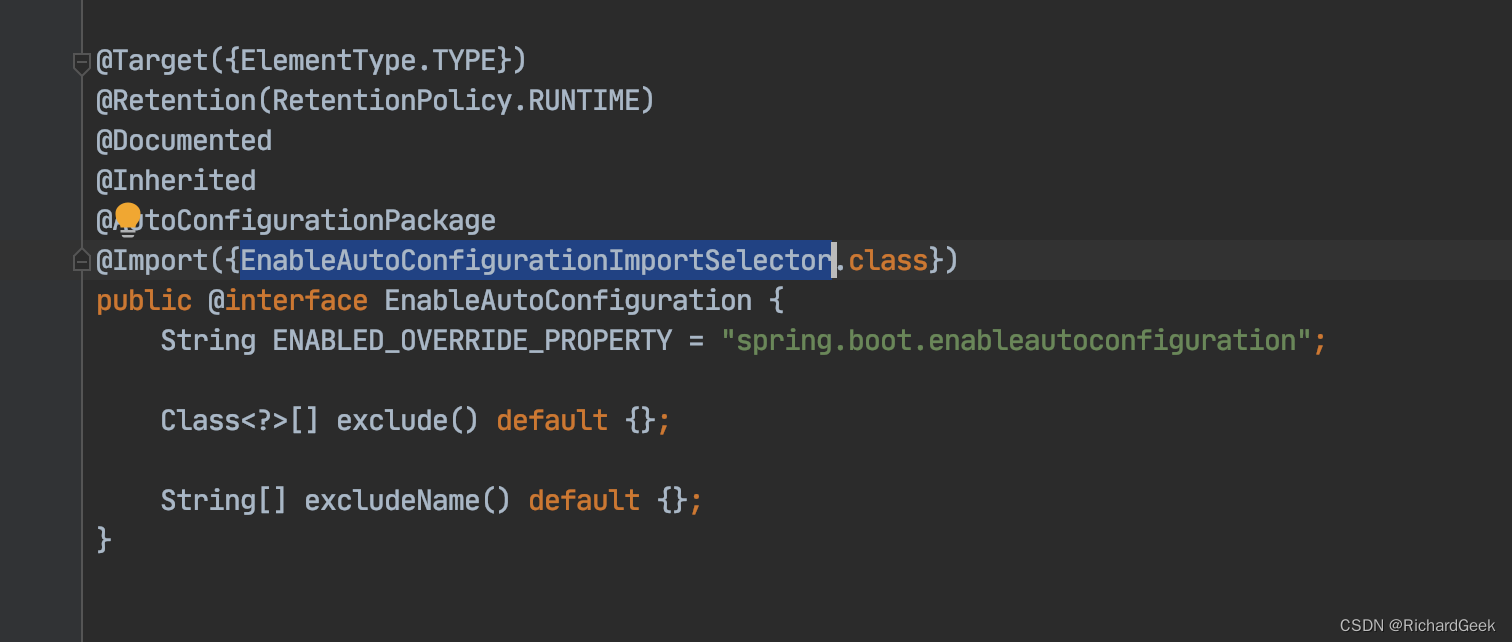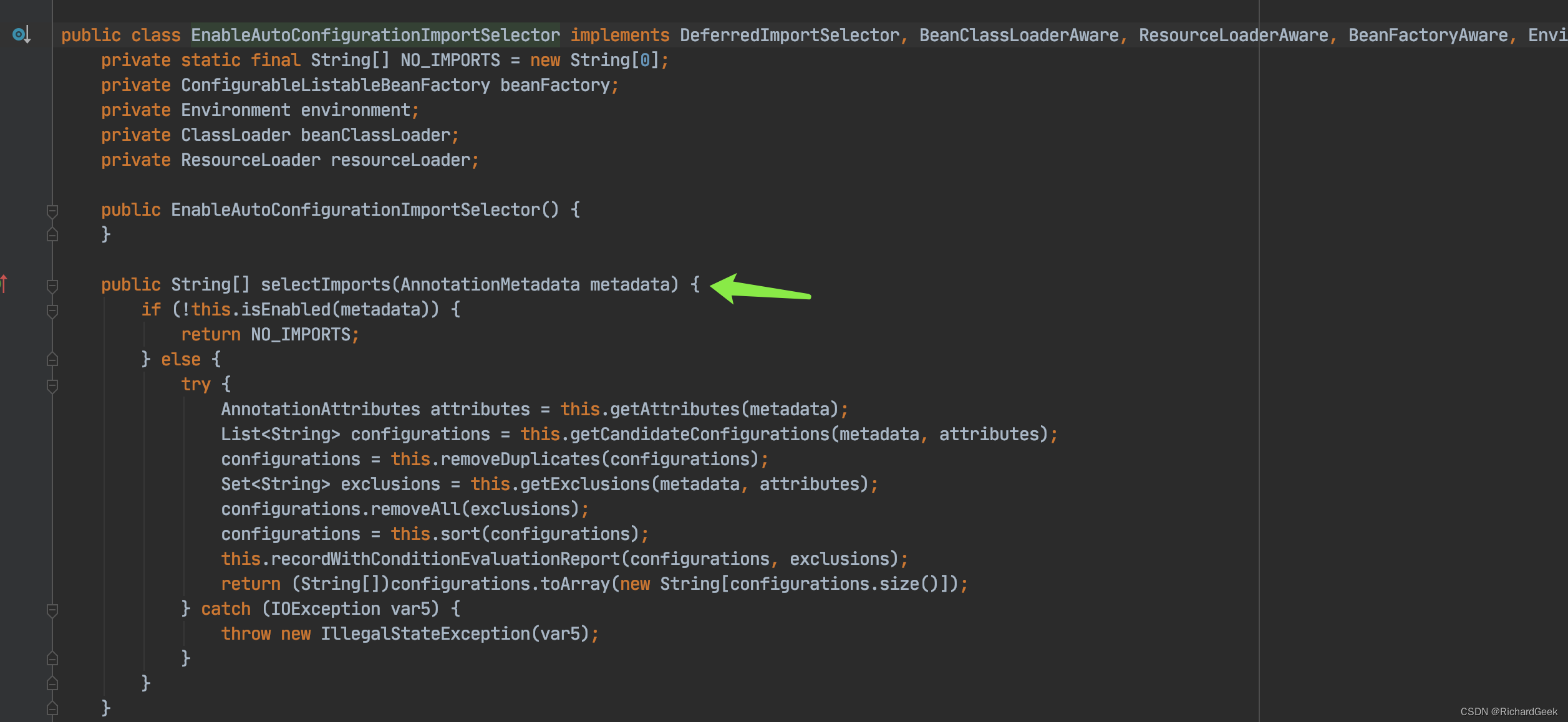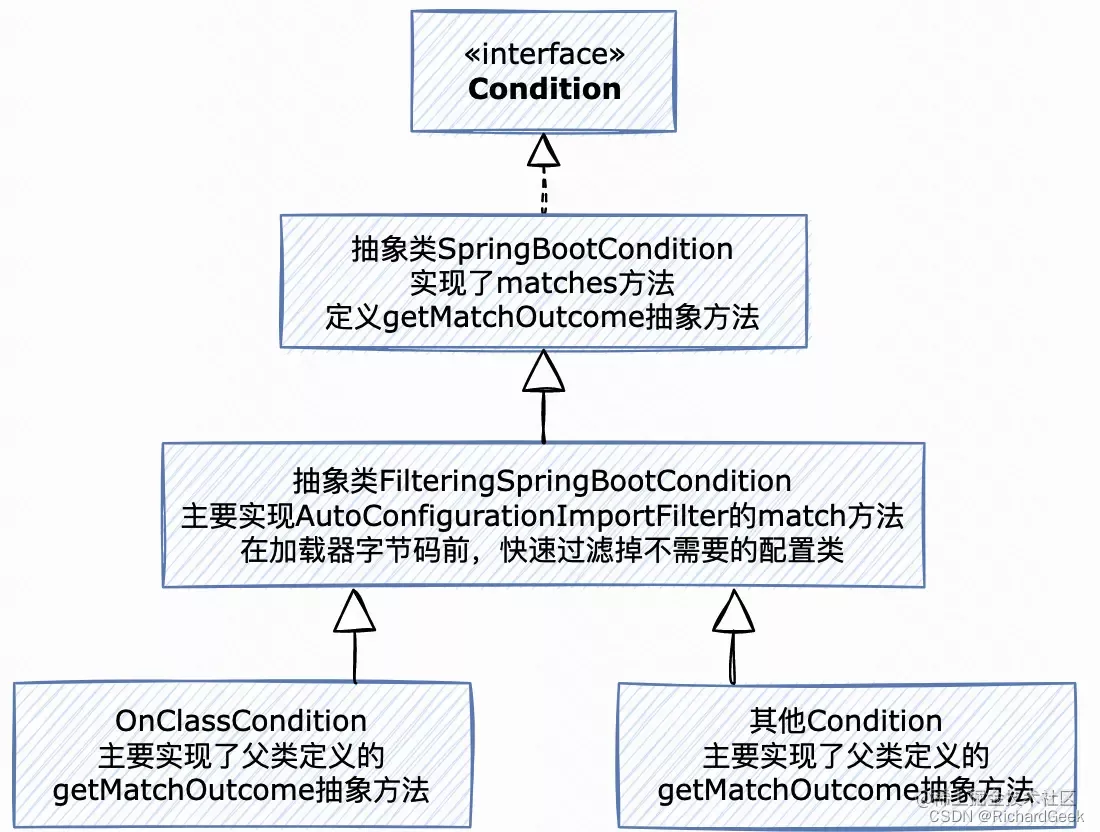目录
理解 EnableAutoConfigurationImportSelector
EnableAutoConfigurationImportSelector 实现类
前言
????????SpringBoot 最核心的功能就是自动装配,Starter 作为 SpringBoot 的核心功能之一,基于自动配置代码提供了自动配置模块及依赖的能力,让软件集成变得简单、易用。使用 SpringBoot 时,我们只需引人对应的 Starter,SpringBoot 启动时便会自动加载相关依赖,集成相关功能,这便是 SpringBoot 的自动装配功能。
????????简单概括其自动配置的原理:由@SpringBootAppliction组合注解中的@EnableAutoConfiguration注解开启自动配置,加载 spring.factories 文件中注册的各种 默认定义的XxxAutoConfiguration 配置类,并且该类可指定@Conditional 条件注解,当其 @Conditional 条件注解生效时,实例化该配置类中定义的 Bean,并注入 Spring 上下文。
自动装配重点项
SpringBoot 自动装配过程涉及以下主要内容:
????????@EnableAutoConfiguration: 扫描类路径下的META-INF/spring.factories文件,并加载其中中注册的 AutoConfiguration 配置类,开启自动装配;
????????spring.factories:配置文件,位于 jar 包的 META-INF 目录下,按照指定格式注册了? ? ? ? ? ? ? ? ? ? ? ?各类AutoConfiguration 配置类。AutoConfiguration 类:自动配置类,SpringBoot 的大量以 xxxAutoConfiguration 命名的自动配置类,定义了三方组件集成 Spring 所需初始化的 Bean 和条件;
????????@Conditional 条件注解及其行生注解:使用在 AutoConfiguration 类上,设置了配置类的实例化条件;
????????Starter:三方组件的依赖及配置,包括 SpringBoot 预置组件和自定义组件,往往会包含
spring.factories 文件、AutoConfiguration 类和其他配置类,其功能间的作用关系如下图:

@SpringBootApplication 注解
????????SpringBoot 项目创建完成会默认生成一个xxxApplication的带有main方法的入口类,通过该类的 main 方法即可启动 SpringBoot 项目,通过调用 SpringApplication 的静态方法 run 作为 SpringBoot 项目的入口,示例代码如下:
@SpringBootApplication
public class LearnSpringBootApplication {
public static void main(String[] args) {
SpringApplication.run(LearnSpringBootApplication.class, args);
}
}????????在 SpringBoot 入口类上,唯一的注解就是 @SpringBootApplication。它是 SpringBoot 项目的核心注解,用于开启自动配置,更准确地说,是组合注解。如包含了@EnableAutoConfiguration开启自动装配功能。
@SpringBootApplication的源码如下:

@SpringBootConfiguration
@EnableAutoConfiguration
@ComponentScan(excludeFilters = { @Filter(type = FilterType.CUSTOM, classes = TypeExcludeFilter.class),
@Filter(type = FilterType.CUSTOM, classes = AutoConfigurationExcludeFilter.class) })
public @interface SpringBootApplication {
// 排除指定的自动配置类
@AliasFor(annotation = EnableAutoConfiguration.class)
Class<?>[] exclude() default {};
// 通过类名的方式排除自动配置类
@AliasFor(annotation = EnableAutoConfiguration.class)
String[] excludeName() default {};
// 指定扫描的包名,激活包下 @Component 等注解组件的初始化
@AliasFor(annotation = ComponentScan.class, attribute = "basePackages")
String[] scanBasePackages() default {};
// 扫描指定类所在包下的所有组件
@AliasFor(annotation = ComponentScan.class, attribute = "basePackageClasses")
Class<?>[] scanBasePackageClasses() default {};
@AliasFor(annotation = ComponentScan.class, attribute = "nameGenerator")
Class<? extends BeanNameGenerator> nameGenerator() default BeanNameGenerator.class;
// 指定是否代理 @Bean 方法以强制执行 bean 的生命周期行为
@AliasFor(annotation = Configuration.class)
boolean proxyBeanMethods() default true;
}@SpringBootApplication注解中组合了@SpringBootConfiguration、@EnableAutoConfiguration和@ComponentScan,其中@SpringBootConfiguration就是@Configuration。在实践过程中也可以使用这3个注解来替代@SpringBootApplication。
理解 @EnableAutoConfiguration
????????上面说到@EnableAutoConfiguration用来开启自动装配功能,接下来重点看下该注解。@EnableAutoConfiguration的主要功能是在启动 Spring 应用程序上下文时进行自动配置,它会尝试配置项目可能需要的 Bean。自动配置通常是基于项目 classpath 中引入的类和已定义的 Bean 来实现的。在此过程中,被自动配置的组件来自项目自身和项目依赖的 jar 包中。
@Target(ElementType.TYPE)
@Retention(RetentionPolicy.RUNTIME)
@Documented
@Inherited
@AutoConfigurationPackage
@Import(EnableAutoConfigurationImportSelector.class)
public @interface EnableAutoConfiguration {
String ENABLED_OVERRIDE_PROPERTY = "spring.boot.enableautoconfiguration";
// 排除指定的自动配置类
Class<?>[] exclude() default {};
// 通过类名的方式排除自动配置类
String[] excludeName() default {};
}
????????上文提到,在 SpringBoot 启动应用上下文的时候,@EnableAutoConfiguration会尝试配置项目可能需要的 Bean,但在实践中如果不需要自定配置相关的 Bean,则可以通过exclude/excludeName让自动化配置类失效,比如不希望数据源(DataSource)自动配置:
@SpringBootApplication(exclude = DataSourceAutoConfiguration.class)
public class LearnSpringBootApplication {
}????????另外,注意注解类上的@AutoConfigurationPackage,通过阅读其 JavaDoc 可知:当basePackages或者basePackageClasses没有指定的话, 被@EnableAutoConfiguration注解的配置类所在的包就是扫描的基础包。
这也是为什么
@SpringBootApplication的主配置类要放在顶级 package 下的原因。
理解 EnableAutoConfigurationImportSelector
????????@EnableAutoConfiguration的自动配置功能是通过@Import注解导入的ImportSelector来完成的。 @Import(EnableAutoConfigurationImportSelector.class)是@EnableAutoConfiguration注解的组成部分,也是自动配置功能的核心实现部分。下面讲解@Import的基本使用方法和ImportSelector的实现类EnableAutoConfigurationImportSelector
@Import 注解
@Import注解,提供了导入配置类的功能。SpringBoot 的源代码中,有大量的EnableXXX类都使用了该注解,了解@Import有助于我们理解 SpringBoot 的自动装配,@Import有以下三个用途:
- 通过
@Import引入@Configuration注解的类; - 导入实现了
ImportSelector或ImportBeanDefinitionRegistrar的类; - 通过
@Import导入普通的POJO。
EnableAutoConfigurationImportSelector 实现类
????????@Import的许多功能都需要借助接口ImportSelector来实现,ImportSelector决定可引人哪些?@Configuration的注解类,ImportSelector接口源码如下:
public interface ImportSelector {
String[] selectImports(AnnotationMetadata importingClassMetadata);
}????????ImportSelector接口只提供了一个参数为AnnotationMetadata的方法,返回的结果为一个字符串数组。其中参数AnnotationMetadata内包含了被@Import注解的类的注解信息。在selectImports方法内可根据具体实现决定返回哪些配置类的全限定名,将结果以字符串数组的形式返回。
????????如果实现了接口ImportSelector的类的同时又实现了以下4个Aware接口,那么 Spring 保证在调用ImportSelector之前会先调用Aware接口的方法。这4个接口为:EnvironmentAware、BeanFactoryAware、 BeanClassLoaderAware和ResourceLoaderAware。
在EnableAutoConfigurationImportSelector的源代码中就实现了这4个接口:
public class EnableAutoConfigurationImportSelector implements DeferredImportSelector, BeanClassLoaderAware, ResourceLoaderAware, BeanFactoryAware, EnvironmentAware, Ordered {
....代码块.....
}????????EnableAutoConfigurationImportSelector实现了ImportSelector的子接口 DeferredlmportSelector。
DeferredlmportSelector接口与ImportSelector的区别是,前者会在所有的 @Configuration 类加载完成之后再加载返回的配置类,而ImportSelector是在加载完 @Configuration 类之前先去加载返回的配置类。
其加载流程如图所示:?

EnableAutoConfigurationImportSelector实现的selectImports方法如下:
 ?getCandidateConfigurations 方法用于获取META-INF/spring.factories的配置类信息:
?getCandidateConfigurations 方法用于获取META-INF/spring.factories的配置类信息:
protected List<String> getCandidateConfigurations(AnnotationMetadata metadata, AnnotationAttributes attributes) {
List<String> configurations = SpringFactoriesLoader.loadFactoryNames(this.getSpringFactoriesLoaderFactoryClass(), this.getBeanClassLoader());
Assert.notEmpty(configurations, "No auto configuration classes found in META-INF/spring.factories. If you are using a custom packaging, make sure that file is correct.");
return configurations;
}其中关键点在于getCandidateConfigurations方法中使用SpringFactoriesLoader的loadFactoryNames方法加载META-INF/spring.factories文件中配置的EnableAutoConfiguration类型的自动配置类:?
public static List<String> loadFactoryNames(Class<?> factoryClass, ClassLoader classLoader) {
String factoryClassName = factoryClass.getName();
try {
Enumeration<URL> urls = classLoader != null ? classLoader.getResources("META-INF/spring.factories") : ClassLoader.getSystemResources("META-INF/spring.factories");
ArrayList result = new ArrayList();
while(urls.hasMoreElements()) {
URL url = (URL)urls.nextElement();
Properties properties = PropertiesLoaderUtils.loadProperties(new UrlResource(url));
String factoryClassNames = properties.getProperty(factoryClassName);
result.addAll(Arrays.asList(StringUtils.commaDelimitedListToStringArray(factoryClassNames)));
}
return result;
} catch (IOException var8) {
throw new IllegalArgumentException("Unable to load [" + factoryClass.getName() + "] factories from location [" + "META-INF/spring.factories" + "]", var8);
}
}看下某些自定义在META-INF/spring.factories文件的部分打算自动装配的Configure内容:

SpringFactoriesLoader 加载了这些xxxAutoConfiguration配置类,通过上面提到的加载、过滤、实例化的过程后,就自动开启某一些具体的功能。
@Conditional 条件注解
????????前面我们看了EnableAutoConfigurationImportSelector是如何进行自动配置类的读取和筛选的,打开每一个自动配置类,我们都会看到@Conditional或其行生的条件注解,其作用是限定自动配置类的生效条件。
????????下面讲一下@Conditional注解原理,@Conditional可根据是否满足指定的条件来决定是否进行 Bean 的实例化及装配(比如,设定当类路径下包含某个类的时候才会对注解的类进行实例化操作),就是根据一些特定条件来控制 Bean 实例化的行为,@Conditional代码如下:
@Retention(RetentionPolicy.RUNTIME)
@Target({ElementType.TYPE, ElementType.METHOD})
public @interface Conditional {
Class<? extends Condition>[] value();
}
public interface Condition {
boolean matches(ConditionContext var1, AnnotatedTypeMetadata var2);
}@Conditional 注解唯一的元素属性是接口 Condition 的数组,只有在数组中指定的所有Condition的matehes方法都返回true的情况下,被注解的类才会被加载:?
@FunctionalInterface
public interface Condition {
// 决定条件是否匹配
boolean matches(ConditionContext context, AnnotatedTypeMetadata metadata);
}????????matches方法的第一个参数为ConditionContext,可通过该接口提供的方法来获得 Spring 应用的上下文信息;matches方法的第二个参数为AnnotatedTypeMetadata,该接口提供了访问特定类或方法的注解功能,可以用来检查带有@Bean注解的方法上是否还有其他注解。
@Conditional 的衍生注解
????????SpringBoot 提供了很多基于@Conditional注解的衍生注解,它们适用不同的场景并提供了不同的功能,这些注解均位于spring-boot-autoconfigure项目的org.springframework.boot.autoconfigure.condition包下,比如:
- @ConditionalOnBean:在容器中有指定 Bean 的条件下
- @ConditionalOnClass: 在 classpath 类路径下有指定类的条件下
- @ConditionalOnMissingBean: 当容器里没有指定 Bean 的条件时
- @ConditionalOnMissingClass:当类路径下没有指定类的条件时
- @ConditionalOnProperty:在指定的属性有指定值的条件
- @ConditionalOnWebApplication:在项目是一个 Web 项目的条件下
????????阅读以上这些注解的源码可以看到,它们都组合了@Conditional注解,通过不同的Condition实现类实现不同的功能,而且用到的实现类大部分都继承自实现了Condition接口的SpringBootCondition抽象类,其继承关系如下:

以ConditionalOnClass为例,看下具体代码:
@Conditional(OnClassCondition.class)
public @interface ConditionalOnClass {
...
}
@Order(Ordered.HIGHEST_PRECEDENCE)
class OnClassCondition extends FilteringSpringBootCondition {
...
}public abstract class SpringBootCondition implements Condition {
@Override
public final boolean matches(ConditionContext context, AnnotatedTypeMetadata metadata) {
String classOrMethodName = getClassOrMethodName(metadata);
try {
// 调用新定义的抽象方法 getMatchOutcome 并交由子类来实现,
// 在 matches 方法中根据子类 getMatchOutcome 返回的结果判断是否匹配
ConditionOutcome outcome = getMatchOutcome(context, metadata);
logOutcome(classOrMethodName, outcome);
recordEvaluation(context, classOrMethodName, outcome);
return outcome.isMatch();
}
catch (NoClassDefFoundError ex) {}
}
// 在抽象类 SpringBootCondition 中实现了 matches 方法,是通过调用新定义的抽象方法 getMatchOutcome 并交由子类来实现
// 在 matches 方法中根据子类返回的结果判断是否匹配
public abstract ConditionOutcome getMatchOutcome(ConditionContext context, AnnotatedTypeMetadata metadata);
}SpringBoot Starter 实践
????????上文已经讲解了 SpringBoot 的核心运作原理,SpringBoot 使用上述自动配置原理实现了许多的starter,可以在项目中快速集成。日常工作中我们可以借鉴 SpringBoot 的 starter 的创建机制来创建自己的starter,这一节我们自己实现一个简单的starter项目,可以快速集成到其他 SpringBoot 项目中。
????????我们设计一个能判断当前环境的starter项目:引入该项目后,会根据环境在 Spring 上下文中自动注入一个对应当前环境的实现IProfileService接口的类Bean,该Bean的getProfile方法能够返回当前的环境名,我们需要根据不同环境注入不同的Bean:
// 不同环境有不同的实现类:DevService、ProdService
public interface IProfileService {
String getProfile();
}????????首先创建一个Maven项目,命名为spring-boot-starter-profile,spring-boot-starter项目依赖spring-boot-autoconfigure,引入其Maven坐标:
<dependency>
<groupId>org.springframework.boot</groupId>
<artifactId>spring-boot-autoconfigure</artifactId>
<version>2.0.1.RELEASE</version>
</dependency>创建com.spring.learn.IProfileService接口和对应dev和prod环境的两个实现类:
public interface IProfileService {
String getProfile();
}// dev 环境下的实现类
public class DevService implements IProfileService{
@Override
public String getProfile() {
return "dev";
}
}// prod 环境下的实现类
public class ProdService implements IProfileService {
@Override
public String getProfile() {
return "prod";
}
}接下来,创建自动配置类 ProfileAutoConfiguration,如何判断环境?我们用上文提到的@ConditionalOnProperty 代替,通过在 properties(或 yml)配置文件中配置profile.service.enabled配置项来模拟不同环境:
@Configuration
@ConditionalOnMissingBean(IProfileService.class) // 容器中不存在 IProfileService 类型的 Bean 时才生效
public class ProfileAutoConfiguration {
@Bean
// profile.service.enabled=dev 时,注入 DevService
@ConditionalOnProperty(prefix = "profile.service", value = "enabled", havingValue = "dev")
public DevService devService() {
return new DevService();
}
@Bean
// profile.service.enabled=prod 时,注入 ProdService
@ConditionalOnProperty(prefix = "profile.service", value = "enabled", havingValue = "prod")
public ProdService prodService() {
return new ProdService();
}
}在resources目录下创建META-INF/spring.factories文件,并填入以下内容:
org.springframework.boot.autoconfigure.EnableAutoConfiguration=\
com.spring.learn.ProfileAutoConfiguration最后,通过mvn clean install将该包安装到本地仓库,方便其他项目引用。
任意打开一个 SpringBoot 项目,引入我们的自定义starter坐标:
<dependency>
<groupId>org.spring.learn</groupId>
<artifactId>spring-boot-starter-profile</artifactId>
<version>1.0-SNAPSHOT</version>
</dependency>在application.properties配置文件中指定下环境配置,模拟不同环境:
profile.service.enabled=prod????????通过SpringApplicationContext获取IProfileService类型Bean,打印getProfile方法获取的环境名称:
public static void main(String[] args) {
ConfigurableApplicationContext context = SpringApplication.run(LearnSpringBootApplication.class, args);
IProfileService bean = context.getBean(IProfileService.class);
System.out.println("get profile from IProfileService: " + bean.getProfile());
}小结
????????本文围绕 SpringBoot 的核心功能展开,从总体上了解 SpringBoot 自动配置的原理以及自动配置核心组件的运作过程,重点学习自动配置原理、@EnableAutoConfiguration、 @lmport、 ImportSelector、@Conditional 以及自定义 starter 示例解析等内容。掌握了这些基础的组建内容及其功能,在集成其他三方类库的自动配置时,才能够更加清晰地了解它们都运用了自动配置的哪些功能。
引申
????????有没有考虑过利用以上的内容原理,实现类似的@SpringBootApplication注解的能力呢?这样就可以不单单的可以实现利用SpringBoot的XxxAutoConfiguration自动装配的能力,而是可拓展更强大的能力,比如注册自定义的bean。相关内容参考:Spring Cloud提供的某些注入启动注解如@EnableEurekaClient、@EnableDiscoveryClient、@EnableEurekaServer等类似逻辑。
如下自定义组合注解@EnableCustomerClient实现注册自定义bean:
@Retention(RetentionPolicy.RUNTIME)
@Target(ElementType.TYPE)
@Documented
@Import({CustomerClientRegistrar.class, CustomerProcessorConfiguration.class}) //定义自定义Registrar 实现ImportBeanDefinitionRegistrar 实现BeanDefinition能力、ProcessorConfiguration配置类实现自定义的某些Bean的创建能力
public @interface EnableCustomerClient {//作为组合启动注解 用于定义在启动类上
String[] value() default {};
String[] basePackages() default {};
Class<?>[] basePackageClasses() default {};
}
public class CustomerClientRegistrar implements ImportBeanDefinitionRegistrar, ResourceLoaderAware, BeanClassLoaderAware, EnvironmentAware {
@Override
public void registerBeanDefinitions(AnnotationMetadata importingClassMetadata, BeanDefinitionRegistry registry) { //重新注册bean定义 importingClassMetadata包含EnableCustomerClient注解的属性内容
//自定义注册逻辑 ,如scan扫包 加载具备某些自定义注解的类对象、过滤等
...
//如最后利用BeanDefinitionReaderUtils.registerBeanDefinition方法实现注册bean定义
ScopeMetadataResolver scopeMetadataResolver = new AnnotationScopeMetadataResolver();
AnnotatedGenericBeanDefinition abd = new AnnotatedGenericBeanDefinition(annotationMetadata);
ScopeMetadata scopeMetadata = scopeMetadataResolver.resolveScopeMetadata(abd);
abd.setScope(scopeMetadata.getScopeName());
AnnotationConfigUtils.processCommonDefinitionAnnotations(abd);
BeanDefinitionHolder definitionHolder = new BeanDefinitionHolder(abd, beanName);
BeanDefinitionReaderUtils.registerBeanDefinition(definitionHolder, registry);
}
}
@Import({XxxProperties.class})
@Configuration
public class CustomerProcessorConfiguration {
@Bean
public ProcessorInitializer processorInitializer(
ApplicationContext applicationContext,
XxxProperties properties) { //注册一个程序初始化启动器
ProcessorInitializer processorInitializer = new ProcessorInitializer(
applicationContext,
properties
);
processorInitializer.initAndStart(); //进行整个初始化行为的初始化和开始方法
return processorInitializer;
}
}
@Slf4j
public class ProcessorInitializer {
private final ApplicationContext applicationContext;
private final XxxProperties properties;
public ProcessorInitializer(ApplicationContext applicationContext, XxxProperties properties) {
Assert.notNull(applicationContext, "applicationContext must not be null");
Assert.notNull(properties, "properties must not be null");
this.applicationContext = applicationContext;
this.properties = properties;
}
public void initAndStart() {//初始化和启动方法的入口
this.init();
this.start();
}
private void init() {
...//自定义业务逻辑 初始化逻辑
}
private void start() {
...//自定义业务逻辑 启动逻辑
}
}????????参考代码:?ImportBeanDefinitionRegistrar实现动态创建自定义bean,自己写的代码封装成BeanDefinition对象示例:ImportBeanDefinitionRegistrar - 愤怒的苹果ext - 博客园、ImportBeanDefinitionRegistrar接口 - 溪水静幽 - 博客园